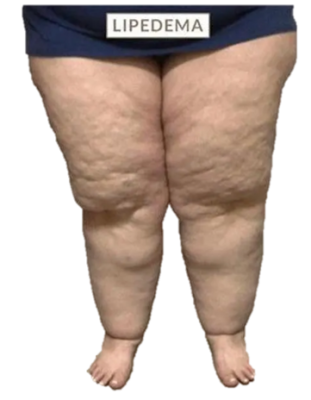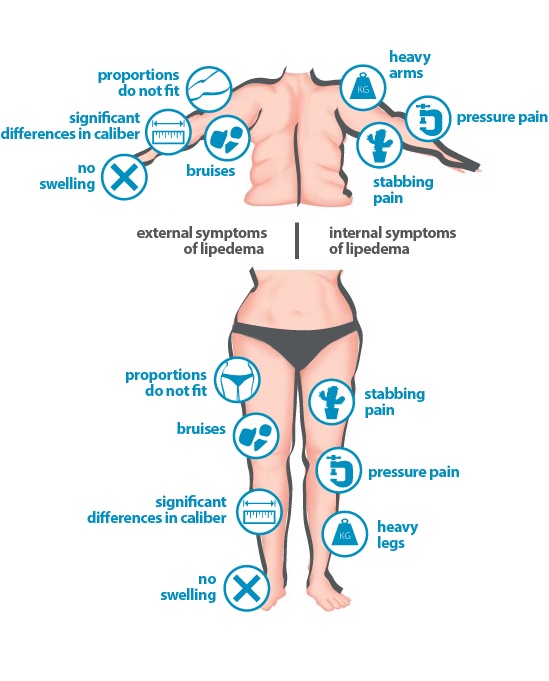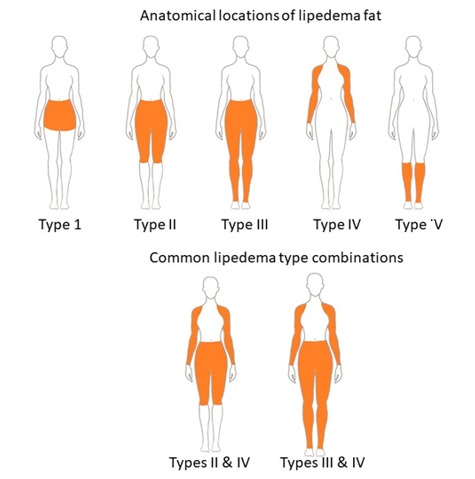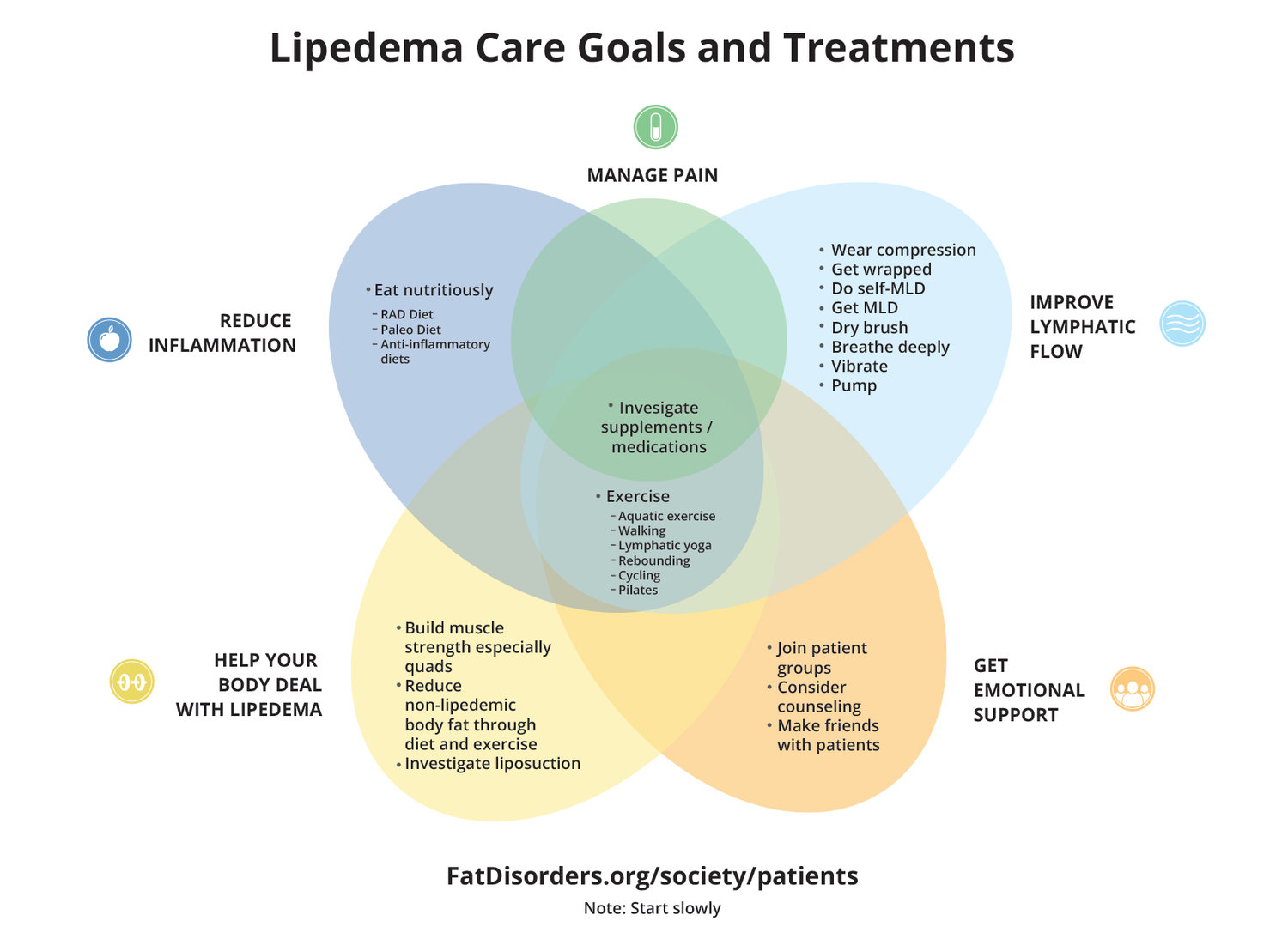Lipedema
What is Lipedema?
Lipedema, also known as lipoedema (and not to be confused with lymphedema), is a disease of inflamed fat cells that affects primarily women. It causes pain and abnormal sensations in the tissues of the legs, hips, and buttocks. It can also affect the arms, although this is less common.
Patients with lipedema typically have large hips and legs in comparison to their waist and upper body. They may appear to have swelling of the legs, but their feet remain normal size. Pressure on the legs can cause significant pain making it uncomfortable for lipedema patients to get massages of the legs or wear compression stockings. Hormonal fluctuations, like menstrual cycles, can worsen symptoms.
Some people with lipedema also have vein disease which can complicate their condition and treatment. With proper treatment, the symptoms of lipedema can be well-managed.



Lipedema is a clinical diagnosis, meaning there is no testing required to make the diagnosis. Signs that you have lipedema can include:
Fat accumulates in the hips and legs
A predisposition to accumulate fat in the hips and legs, rather than evenly throughout the body.
Fat can sometimes gather abnormally, “clumping” in areas like the outer hips and thighs.
Weight loss will first affect the upper body, leaving the legs disproportionately large.
Legs often feel tender to the touch.
Even light pressure can cause pain.
Patients may report strange, hard-to-describe sensations in the legs.
i.e. “creepy-crawley”
Restless legs – Legs may also be restless at night
Patients may report easy bruising of the legs, even without a known injury.
Things like diuretics, commonly called “water-pills” don’t tend to change leg size or the perception of swelling.
Lipedema tends to run in families with the women having similar body shaped lower bodies.

The treatment for lipedema first requires an accurate diagnosis. Many healthcare providers are not familiar with lipedema. If you suspect you have lipedema but have not been diagnosed, you may want to consider seeing a vascular specialist. Vascular providers are typically well-informed about the most common causes of leg pain and they can help rule-out other causes or contributors to your symptoms. Typical treatment for lipedema includes:
Compression
Compression garments help to force inflammatory products out of the legs and prevent them from building back up.
Should be worn during the day and removed at night, prior to bedtime.
Consistent use of well-fitting compression garments can help reduce the remodeling and enlargement of affected limbs.
Compression garments can sometimes be uncomfortable for lipedema patients so there can be some degree of trial-and-error.
Options include knee-high socks, thigh-high stockings, pantyhose, and leggings
Compression leggings may be the most comfortable since there are no tight bands around the legs.
Leggings should be avoided if there is swelling in the feet.
Try starting with lighter compression (15-20 mmHg), and work up to tighter compression (20-30 mmHg).
Some patients may also benefit from a device called a pneumatic compression pump which consists of sleeves for the legs that inflate with air, gently massaging the legs and encouraging the flow of lymphatic fluid.
Diet
Lipedema patients may benefit from an anti-inflammatory diet.
Avoid processed and pre-made foods and opt for whole-food, homemade options.
Avoid saturated fats and meats and opt for a plant-based diet with occasional lean proteins.
Eat more fruits and veggies.
Drink plenty of water.
Incorporate natural anti-inflammatories, like garlic and turmeric, into your cooking or add a supplement.
Weight management is important to slow disease progression. More fat = more opportunity for symptoms to develop or worsen.
It is important that note that weight loss does not cure the discomfort associated with lipedema and is therefore an inappropriate stand-alone therapy.
Exercise
Regular, low-impact exercise can help to manually force inflammatory products in the tissues out of the legs.
Exercise may also help to reduce the symptoms of hormonal fluctuations.
Liposuction
Many patients become discouraged when weight loss fails to alleviate their pain. It may not even significantly change the size of their legs. Lipedema patients can consider liposuction for better results. Removing the inflamed fat cells appears to be very effective for many patients. Unfortunately, insurance coverage for this procedure is quite limited. Before considering liposuction for lipedema, seek out a plastic surgeon who specializes in the disease.
Vascular Care
Some patients with lipedema may also have deep or superficial vein disease that is contributing to their symptoms.
Not all vein disease is obvious but some signs and symptoms include:
Spider and/or varicose veins
Leg swelling
Leg Discoloration – Darkening of the skin around the calves or ankles
Heaviness or fatigue of the legs
Itching or restlessness of the legs
Treating vein disease can help to eliminate some leg symptoms like discomfort and swelling.

